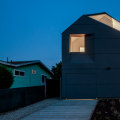Are you looking to make your home more energy-efficient? If so, you're in the right place. An energy-efficient home has much higher insulation R-values than those required by most local building codes. An R-value is the ability of a material to resist heat transfer, and the lower the value, the faster the heat loss. An energy-efficient home is designed to conserve and reduce energy use, and there are a lot of things to consider when making your home more efficient. Prefabricated homes (formerly known as mobile homes) are built according to the U.
S. Department of Housing and Urban Development (HUD) code and are built on a permanent chassis so that they can be moved. Homeowners can improve the energy efficiency of these homes by using sealants and weatherstripping, sealing the air, and choosing energy-efficient lighting and appliances. Did you know that 25 to 30% of your home's heating and cooling use (and therefore the cost) is due to heat gain and loss through windows? Insulating them or investing in three-paned glass can keep the climate right outside your home. You can also prevent drafts by insulating doors, attic hatches, outdoor pipes, and roof-to-wall joints.
And speaking of attic hatches, when was the last time you checked the depth of attic insulation? Do you have the recommended depth of 10 to 14 inches? An efficient home is one that reduces unnecessary energy consumption, greenhouse gas emissions and the demand for non-renewable resources. At the same time, it provides more sustainable living conditions and saves significant sums of money. If you're looking for a new home in Houston, Dallas, Austin, or San Antonio, make sure Chesmar Homes is among the first on your list of builders to consider. The popularity of these clean, renewable energy sources is rapidly increasing both among businesses and among homes. Knowing what makes a home energy efficient can help you choose a home that's great for the environment and your health.
Rooms with windows facing north and east do not receive an excess of light and are usually cooler than the rest of the house. These homes have done it all, including installing energy-saving appliances such as air conditioning, 26% of heating units, and meeting strict standards for air quality, greenhouse gas emissions, water conservation and materials. A home's freshwater consumption is its water footprint, which can be reduced with intelligent water management systems. The basic rule of the circular economy is the 3Rs (reuse, recycling and reduction) and it has a direct application in the construction and use of housing. We'll break it down with some quick and easy ways to help the environment and your bank account by reducing your home's energy consumption. Heating and cooling systems consume more energy than other appliances, so a smart thermostat is a great way to reduce energy consumption.
For example, when you reduce greenhouse gas emissions that cause climate change, your efficient home helps combat global warming. In an existing home, the first step is to perform a home energy assessment (sometimes referred to as an energy audit) to find out how your home uses energy and determine the best ways to reduce energy consumption and costs. If energy efficiency wasn't a priority on your shopping list, you can consider converting an energy-intensive home into a green home by applying for an energy-efficient mortgage for renovations (yes, that's possible).If you're building a new home or expanding an existing one, consider using advanced structures (also known as optimal value engineering), which reduce wood use and waste and improve energy efficiency in a wood-framed home. It prevents heat transfer from the inside to the outside of the house, so heating and cooling systems don't have to work too hard.



